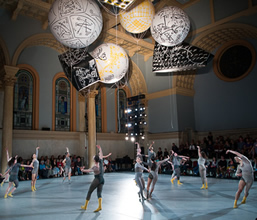Apologizing to Berlioz and Burt Bacharach in advance, conductor Grant Llewellyn took the podium and declared to his audience the theme of this concert: the three Bs. With the help of the NC Master Chorale (Alfred E. Sturgis, director), the NC Symphony presented a crowd-pleasing program of Bach, Brahms and Beethoven.
Beyond common letters, however, the program made sense on a deeper level: Brahms and Beethoven (like everyone else with functional ears) adored Bach’s music, building on his rich harmonic language and astonishing contrapuntal achievements in their own works. As listeners moved through this concert, then, they witnessed the development of a musical tradition stretching from the Baroque period to the late Romantic era.
The program opened accordingly, with the orchestra and choir combining forces for Bach’s haunting motet, Jesu, meine Freude, S.227. Being fairly large in size, the NC Master Chorale struggled to navigate the dense contrapuntal landscape of the opening few movements. The inner voices, in particular, didn’t clarify their own lines vis-à-vis the recurring soprano melody and often sounded muddy as a result. Yet in certain movements, like the gorgeous “Gute Nacht, o Wesen,” only a sub-section of the choir sang, and individual lines came through with a crystal-like clarity. Big choir Bach is tough stuff.
When the program shifted from Lutheran devotion to Romantic angst, however, the big choir paid off. Brahms’ Schicksalslied plays off the contrast between celestial peace and earthly finitude, generating a sense of longing for the former by the latter. Brahms sets this contrast to music vividly, shifting from ethereal, dreamlike passages into the intensely dramatic “Doch uns ist gegeben, auf keiner Stätte zu ruh’n” (“To us is given, no place for rest”). The choir sang the opening sections with a soft, simmering intensity, only then to explode into a raucous fortissimo at the introduction of the “Doch uns ist gegeben” text. Big choir Brahms is spine-tingling stuff.
After intermission, with the choir gone, all attention was focused on the orchestra’s thrilling playing of one of Beethoven’s very finest symphonies, No. 3, “Eroica.” This symphony is famous for its connections to the French Revolution, both in Beethoven’s (later retracted) dedication of it to Napoleon and in its overturning of traditional convention, ending the opening cello melody on a C sharp in measure 7.
Those socio-political resonances may have faded over time, but the epoch-generating power of the music itself has not. Llewellyn chose a suitably moderate tempo for the first movement, sticking to it even as some orchestral players got carried away with the frenetic energy of the piece and rushed ahead of him in a few places. The second movement, although polished to a shine, somehow lacked the funerary grandeur for which it is so celebrated. I waited to be engulfed by the sublime and it didn’t quite come off. The third movement, however, was sheer exuberance. Llewellyn really threw caution to the wind – in the good sense – and let this movement be the romp that it is. The fourth followed in tow, with Llewellyn almost dancing right off the podium in excitement.
If you love any of the “three Bs,” or just fine orchestral playing in general, this concert is for you. Repeat performances are in Meymandi Concert Hall on March 14 at 8 p.m. and UNC’s Memorial Hall on March 15 at 7:30 p.m. For details, see the sidebar.












